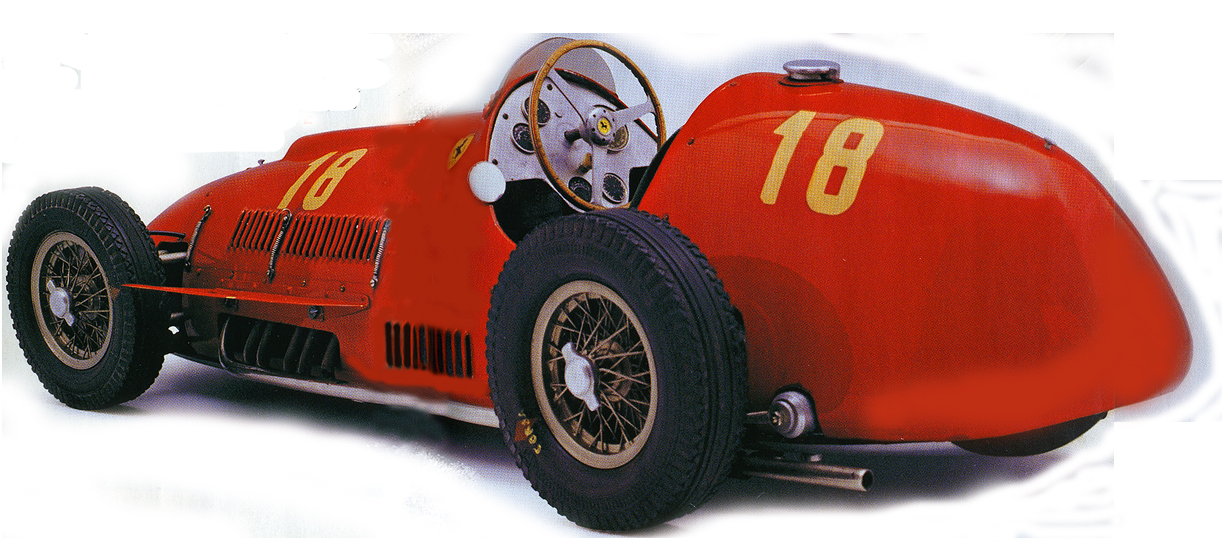

Since the other chapters of this site were published, I have been fortunate enough to hear from a very enthusiastic and generous collector in Italy, who has furnished me with a large amount of information on another of Henri's models that was exported to Italy way back in the early 1950s. This was, to me, of very special significance as I was given a large proportion of this model to execute. I was asked to carve the hardwood former and to beat out the body-shell over it. The louvres were cut with a follow-up jig and press-tool which I was given to make as that was a regular task of mine since the Delahaye bonnet louvres. Another of my allocated task was the spoked wheels and tyres. I was given the task of making the form-tools for the brass rims and hubs for all the spoked-wheels of that era and the making of the lacing jig for the spoking. Henri made all the chassis and suspension parts except the aliminium tray. Also the exhausts, steering wheel, dash and instruments, mirrors and the spray-painting and the original decals. The toughest job I had was that complicated grill which was carved out of brass sheet and was of 'egg-box' construction which had to be fitted to a very exact fit because my father insisted on brazing that showed only a very thin line before plating. If daylight showed, then I had to start again. All the fitting was done by hand with a small warding-file which I still have. I spent three weeks and several new attempts on this beast before I came up with the acceptable standard that passed Henri's exacting standards. I can remember vividly being revived by my father when I had collapsed due to the enormous mental and physical stress during a prolonged period of time-pressure due to this part and its difficulties. This car was built for an Italian client, Carlo Mallia TabonI0 who was at Tecnimodel of Rome. They were listing and selling our cars on a regular basis, so time was of the essense.
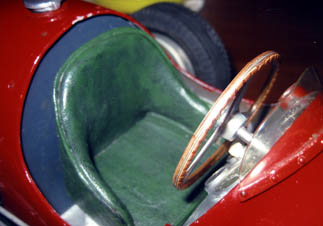
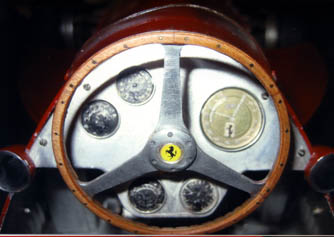
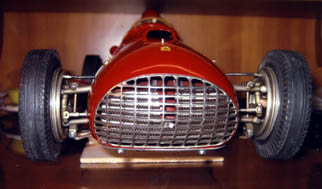
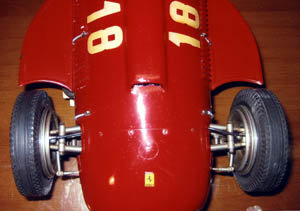
click on images above for enlargements for some of the items
click on images above for readable enlargements
Here is a rough International English translation of the original Italian text:
"Giuseppe Scarani of Bologna realized the dream of every collector: accidentally found a merchant of antique auto-models of great value and to succeed to acquire them without spending an amount that did not put him in a spin. In fact it happened only a few months ago, when Scarani was looking around the city, on a stall of an antique-dealer that sells furnishings, the single auto body in aluminum, displaying real handicraft and complete with seat and dashboard, of one Ferrari 375 in 1:10 scale. Without showing too much interest, he asks the price and acquires it. Then, he asks the antique-dealer if he has the rest of the machine, the chassis plate, the wheels and the exhausts. The first answer and negative, but as a result of the repeated insistences of the new owner, the trader promises to try in the warehouse. Some days after, Scarani receives the wonderful news: hidden inside of the group of furnishings from where the auto’s body was found, the antique-dealer had found some other pieces, in perfect state. Scarani acquired these and sends them all to George Pontoni, of Turin, who specialized in the restoration of old models, thus he restored the Ferrari, bringing back it to all its splendor. With a length of approximately 40 cm and width 15 cm, it represents the twelve cylinder Ferrari F1 car that raced in the World Championship in 1951 with drivers Villoresi, Gonzales, Ascari and Taruffi and that took part in that famous victory in England Silverstone, in England, where he overtook the Alfa Romeo 159."
"But let us return to the model, outstanding in the second half of the 1950s and created by H.C. Baigent, a craftsman of Bournemouth, in the South of England, maker of other reproductions in scale, mainly engine powered. This static facsimile has, as the main characteristic, the fidelity to be as the original. Every detail is realized, and in fact with extreme attention and, probably, Baigent has had the occasion to see the original single-seater. The contest number is 18, the one with which Luigi Villoresi raced in the GP of Switzerland. As pointed out, the auto-body is in aluminum, as it was found. The suspensions work and are completely identical to the original car. The steering wheel is covered in real wood, the seat in skin while the tyres have been made from the original mould. The finish painting is still the original and also the hand-painted numbers are original. A reproduction of the engine is not present and, for this reason, the bonnet does not open, but the spring-straps can make you think it does. But, this does nothing to spoil the beauty of the model."
Translation of the captions to the pictures:
"PERFECT REPLICA: The long tail houses, the same as in the original car, the fuel tank. Note the dashboard, with the dash in aluminum and steering wheel with three spokes, with rim in wood (true)."
"1:10 SCALE: The grill is made from brass, and like on real Ferrari 375, turns out to be a prominent feature of the auto body. The brakes-drums are copied to perfection, as are the suspensions. This model is an only copy and is worth several thousand euros."
"WINNER AT SILVERSTONE: The model created by Henri Baigent in the 1950s, and in the background., Gonzales in the 375 F1 during a pit stop in the G.P. of Silverstone on 14th July 1951."
The above model appeared in an Italian magazine in 2002, a scan of which is reproduced above with a loose translation,
click on the images for readable enlargements